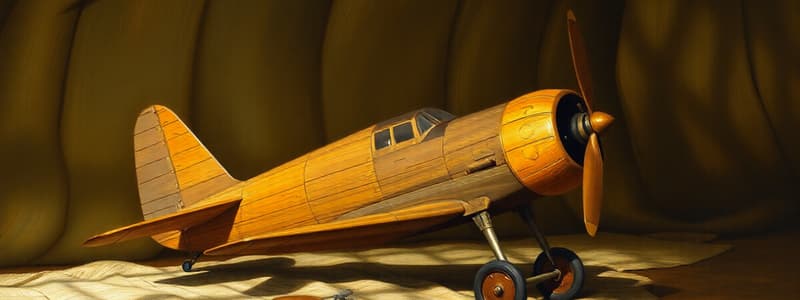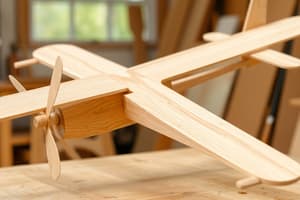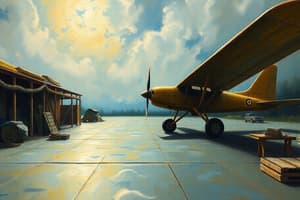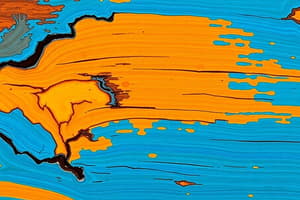Podcast
Questions and Answers
Why was wood the primary material for aircraft construction until the 1930s?
Why was wood the primary material for aircraft construction until the 1930s?
- Strong, lightweight metal aircraft structures were not yet fully developed, and suitable corrosion-resistant materials for all-metal aircraft were lacking. (correct)
- Wood was fireproof and more durable than other materials.
- Pilots preferred the aesthetic and feel of wooden aircraft.
- Wood was significantly cheaper than aluminum and easier to mass-produce.
What contributed to the continued use of fabric coverings in modern aviation despite the dominance of aluminum and composite aircraft?
What contributed to the continued use of fabric coverings in modern aviation despite the dominance of aluminum and composite aircraft?
- Advances in fabric coverings make them suitable for gliders, home-builts, light sport aircraft, and some standard/utility certificated aircraft. (correct)
- Fabric coverings are easier to repair and maintain compared to aluminum or composite materials.
- The cost of manufacturing fabric-covered aircraft is significantly lower, making them more accessible to consumers.
- Fabric coverings are mandated by aviation regulations for specific aircraft types.
What is the main advantage of using fabric covering on an aircraft?
What is the main advantage of using fabric covering on an aircraft?
- Enhanced durability
- Improved aerodynamics
- Light weight (correct)
- Increased resistance to corrosion
Which of the following is a disadvantage of using fabric coverings on aircraft?
Which of the following is a disadvantage of using fabric coverings on aircraft?
What material is now the standard for fabric coverings on United States certificated aircraft?
What material is now the standard for fabric coverings on United States certificated aircraft?
What is a characteristic of conical engine mounts that distinguishes them from other types?
What is a characteristic of conical engine mounts that distinguishes them from other types?
How many points do conical engine mounts typically use to fasten an engine and secure the mount to the airframe?
How many points do conical engine mounts typically use to fasten an engine and secure the mount to the airframe?
What is a defining characteristic of dynafocal engine mounts?
What is a defining characteristic of dynafocal engine mounts?
Which factor determines the attachment locations in the design of dynafocal engine mounts?
Which factor determines the attachment locations in the design of dynafocal engine mounts?
Which type of engine mount is often used with diesel and/or rotax engines, and differs in shape from dynafocal and conical mounts?
Which type of engine mount is often used with diesel and/or rotax engines, and differs in shape from dynafocal and conical mounts?
Where is the engine typically situated when using a bed mount?
Where is the engine typically situated when using a bed mount?
What material is commonly used to construct the engine mount structure for reciprocating engines?
What material is commonly used to construct the engine mount structure for reciprocating engines?
What are the rubber and steel engine suspension units designed to absorb vibration called?
What are the rubber and steel engine suspension units designed to absorb vibration called?
What material are most turbine engine mounts made of?
What material are most turbine engine mounts made of?
Where are the engine mounts typically located on turbofan engines?
Where are the engine mounts typically located on turbofan engines?
What is a key design consideration for turbofan engine mounts regarding safety?
What is a key design consideration for turbofan engine mounts regarding safety?
What is the primary reason for designing turbofan engine mounts to release the engine under extreme forces?
What is the primary reason for designing turbofan engine mounts to release the engine under extreme forces?
What are the connection bolts or fuse pins of engine/pylon mounts designed to do in the event of extremely high loads?
What are the connection bolts or fuse pins of engine/pylon mounts designed to do in the event of extremely high loads?
What is the purpose of 'location numbering systems' in aircraft design and maintenance?
What is the purpose of 'location numbering systems' in aircraft design and maintenance?
Before attempting to locate a structural member on an aircraft using a numbering system, what should always be reviewed?
Before attempting to locate a structural member on an aircraft using a numbering system, what should always be reviewed?
What is the term for the reference or zero point from which fuselage stations are numbered?
What is the term for the reference or zero point from which fuselage stations are numbered?
In what unit are fuselage stations (Fus. Sta. or FS) typically numbered?
In what unit are fuselage stations (Fus. Sta. or FS) typically numbered?
What is the definition of the 'buttock line' (BL) in aircraft measurements?
What is the definition of the 'buttock line' (BL) in aircraft measurements?
What does the 'water line' (WL) represent in aircraft measurements?
What does the 'water line' (WL) represent in aircraft measurements?
Which of the following characteristics is true regarding aircraft constructed with wood frames and fabric coverings during World War I?
Which of the following characteristics is true regarding aircraft constructed with wood frames and fabric coverings during World War I?
In the context of aircraft maintenance, what is an accepted procedure for fabric aircraft?
In the context of aircraft maintenance, what is an accepted procedure for fabric aircraft?
What are the key features that define a conical engine mount, and why are they considered the easiest to maintain?
What are the key features that define a conical engine mount, and why are they considered the easiest to maintain?
The Dynafocal engine mount points are designed to distribute torque and vibration efficiently. What shape characterizes these points, and how does this design benefit vibration absorption compared to a conical mount?
The Dynafocal engine mount points are designed to distribute torque and vibration efficiently. What shape characterizes these points, and how does this design benefit vibration absorption compared to a conical mount?
What factor is most critical when designing dynafocal engine mounts, and how does this affect the mount's overall performance and complexity?
What factor is most critical when designing dynafocal engine mounts, and how does this affect the mount's overall performance and complexity?
What characteristic makes the bed mount distinct and which types of engines are they often paired with?
What characteristic makes the bed mount distinct and which types of engines are they often paired with?
Welded steel tubing is often used for engine mount structures. With the understanding that increased engine power caused a need for vibration absorption, what additional components are used?
Welded steel tubing is often used for engine mount structures. With the understanding that increased engine power caused a need for vibration absorption, what additional components are used?
Turbofan engines commonly use stainless steel mounts. How are the mounts arranged to support the engine and manage the loads imposed on the aircraft structure?
Turbofan engines commonly use stainless steel mounts. How are the mounts arranged to support the engine and manage the loads imposed on the aircraft structure?
In terms of safety factors, how are turbofan engine mounts designed to behave under extreme shear loads that go past a certain limit, and what’s the result?
In terms of safety factors, how are turbofan engine mounts designed to behave under extreme shear loads that go past a certain limit, and what’s the result?
When extreme forces are applied, turbofan engine mounts are designed to release the engine. How is this achieved? What effect does this have on any structural damage to other parts of the plane?
When extreme forces are applied, turbofan engine mounts are designed to release the engine. How is this achieved? What effect does this have on any structural damage to other parts of the plane?
What is essential to examine and understand, based on each manufacturer's guidelines, prior to pinpointing the location of a structural part?
What is essential to examine and understand, based on each manufacturer's guidelines, prior to pinpointing the location of a structural part?
Fuselage stations play a crucial role, how are fuselage stations numbered and what reference point is key for this system?
Fuselage stations play a crucial role, how are fuselage stations numbered and what reference point is key for this system?
The center reference from which left or right measurements are made. What is this called?
The center reference from which left or right measurements are made. What is this called?
Waterline (WL) is a specific height measure. How does the Waterline differ from the Buttock Lines or Fuselage stations? What are they?
Waterline (WL) is a specific height measure. How does the Waterline differ from the Buttock Lines or Fuselage stations? What are they?
Flashcards
Aircraft Wood
Aircraft Wood
Wood was among the first materials used to construct aircraft. Many early planes used wood frames with fabric.
Existing Wooden Aircraft
Existing Wooden Aircraft
Many older airplanes constructed with wood still exist, operating with proper maintenance and repair.
Advantage of Fabric Covering
Advantage of Fabric Covering
The primary advantage of aircraft fabric is its light weight, contributing to overall aircraft efficiency.
Disadvantages of Fabric Covering
Disadvantages of Fabric Covering
Signup and view all the flashcards
Standard Aircraft Fabric
Standard Aircraft Fabric
Signup and view all the flashcards
Conical Engine Mounts
Conical Engine Mounts
Signup and view all the flashcards
Identifying Conical Mounts
Identifying Conical Mounts
Signup and view all the flashcards
Dynafocal Engine Mounts
Dynafocal Engine Mounts
Signup and view all the flashcards
Dynafocal Mount Design
Dynafocal Mount Design
Signup and view all the flashcards
Bed Engine Mounts
Bed Engine Mounts
Signup and view all the flashcards
Engine Mount Material
Engine Mount Material
Signup and view all the flashcards
Shock Mounts
Shock Mounts
Signup and view all the flashcards
Mounting Bolts
Mounting Bolts
Signup and view all the flashcards
Turbofan Mounts: Function
Turbofan Mounts: Function
Signup and view all the flashcards
Turbofan Mount Configuration
Turbofan Mount Configuration
Signup and view all the flashcards
Turbofan Mount: Safety
Turbofan Mount: Safety
Signup and view all the flashcards
Vibration Isolator Mounts
Vibration Isolator Mounts
Signup and view all the flashcards
Location Numbering Systems
Location Numbering Systems
Signup and view all the flashcards
Fuselage Stations (FS)
Fuselage Stations (FS)
Signup and view all the flashcards
Butt Line (BL)
Butt Line (BL)
Signup and view all the flashcards
Water Line (WL)
Water Line (WL)
Signup and view all the flashcards
Study Notes
- Aircraft Wood
Materials
-
Wood was one of the first materials used in aircraft construction.
-
Most airplanes during World War I used wood frames with fabric coverings.
-
Wood was preferred for aircraft construction until the 1930s.
-
The slow development of strong, lightweight metal structures contributed to the use of wood.
-
A lack of corrosion-resistant materials for all-metal aircraft was also a factor.
-
Many airplanes with wood as the primary structural material still exist and are in operation.
-
Proper maintenance and repair are essential to keep these older aircraft airworthy and operational.
-
The largest seaplane and wooden aircraft ever constructed was made of wood.
-
Aircraft Fabric
-
Fabric-covered aircraft have significantly impacted aviation history.
-
Fabric covering provides a primary advantage for planes: lightweight.
-
Disadvantages of using fabric coverings on planes include: flammability and lack of durability.
-
As aviation advanced, aluminum became the main construction material.
-
Aluminum and composite planes dominate modern aviation.
-
Gliders, home-built aircraft, light sport aircraft, and some standard and utility aircraft still get built with fabric coverings.
-
Polyester fabrics are now standard, with linen and cotton no longer used on planes certified in the U.S.
-
Recovering existing fabric aircraft is an accepted maintenance procedure.
-
Engine mounts
Mounts for Reciprocating Engines
- Aircraft equipped with reciprocating engines use a mount structure made of welded steel tubing.
- As engines grew, the need to absorb vibration led to the development of rubber and steel engine suspension units which are known has shock mounts.
- These mounts are secured using heat-treated steel bolts.
- The three most common engine mounts are:
- Conical
- Dynafocal
- Bed Mount
Conical Mount
- Conical engine mounts were developed first, and these suits traditional aircraft and smaller engines.
- Conical mounts are strong and sturdy, having four points to fasten the engine and secure the mount to the airframe.
- They are considered the easiest for installation, repairs, and maintenance.
- Conical mounts are used if crankcase pads are flat and the mounting bolts are installed horizontally through the mount and engine.
Dynafocal Mount
- Dynafocal mounts are known as the strongest engine mounts.
- Like conical mounts, dynafocal ones also have four fastener points: a ring shape around the engine for better torque and vibration distribution.
- Dynafocal mounts use larger rubber discs to cushion vibrations more effectively than the smaller cone-shaped rubbers in conical mounts.
- The attachment locations are based on the engine's center of gravity.
- The design systems have a specific position that the mounts point toward, becoming the center of gravity for the entire system, including all additional elements of the system, the engine accessories, and propeller.
- Dynafocal engine mounts are much more difficult to design and build.
Bed Mount
- Bed mounts are common in diesel and Rotax engines.
- Unlike dynafocal and conical mounts, bed mounts have a diverged shape.
- Bed mounts still use four attachment points, but are situated under a crankcase/beneath the firewall.
Turbofan Engines
-
Engine mounts for turbofan engines support the engine and manage loads imposed on the aircraft structure.
-
Most turbine engine mounts are made of stainless steel.
-
Some systems include two mounts supporting the forward end and a single mount at the rear end.
-
Vibration isolator engine mounts support the power plants and isolate the airplane structure.
-
Each power plant is generally supported by forward and aft vibration isolator mounts
-
For safety, turbofan mounts are designed to break off if shear loads exceed a threshold.
-
The engine-to-wing structure releases the engine during extreme forces to prevent structural damage to the wing, which could impair flight.
-
The design philosophy for turbofan engines differs from safe load design and varies by aircraft.
-
Connection bolts/fuse pins of engine/pylon mounts can fail in a controlled manner if loads are extremely high, which endangers aircraft structure.
-
Location Numbering Systems
Overview
- Both small and light aircraft require a method to precisely locate each structural component.
- Numbering systems facilitate the location of wing frames, fuselage bulkheads, and other structural parts.
- Most manufacturers use station marking systems.
- Always review the manufacturer's numbering system and designations before locating a structural member, as these are not always the same across manufacturers.
Key Terms
- These are numbered in inches from a reference or zero point known as the reference datum.
- Buttock Line (BL): The vertical reference plane down the center of the aircraft used for left or right measurements.
- Water Line (WL): Measurement of height in inches perpendicular from a horizontal plane, usually located at the ground, cabin floor, or another easily referenced location.
Studying That Suits You
Use AI to generate personalized quizzes and flashcards to suit your learning preferences.




